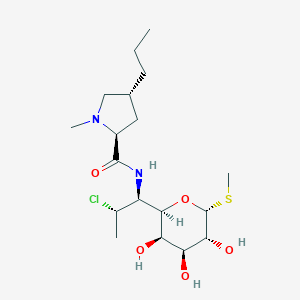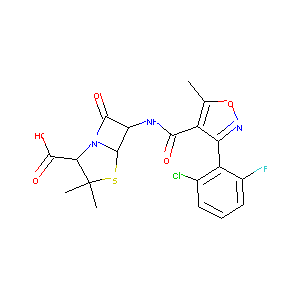| 1 |
ClinicalTrials.gov (NCT01876628) Adjunctive Clindamycin for Cellulitis: C4C Trial.
|
| 2 |
Drugs@FDA. U.S. Food and Drug Administration. U.S. Department of Health & Human Services. 2015
|
| 3 |
Clindamycin FDA Label
|
| 4 |
Drug information of Flucloxacillin, 2008. eduDrugs.
|
| 5 |
Flucloxacillin and paracetamol induced pyroglutamic acidosis. BMJ Case Rep. 2021 Jan 8;14(1):e237536.
|
| 6 |
Structural basis for the interaction of antibiotics with the peptidyl transferase centre in eubacteria. Nature. 2001 Oct 25;413(6858):814-21.
|
| 7 |
In vitro metabolism of clindamycin in human liver and intestinal microsomes. Drug Metab Dispos. 2003 Jul;31(7):878-87.
|
| 8 |
Comparison of antimicrobial susceptibility, beta-lactamase production, plasmid analysis and serum bactericidal activity in Edwardsiella tarda, E. ictaluri and E. hoshinae. J Med Microbiol. 1993 Oct;39(4):273-81.
|
| 9 |
A comprehensive in vitro and in silico analysis of antibiotics that activate pregnane X receptor and induce CYP3A4 in liver and intestine. Drug Metab Dispos. 2008 Aug;36(8):1689-97.
|
| 10 |
Systems pharmacological analysis of drugs inducing stevens-johnson syndrome and toxic epidermal necrolysis. Chem Res Toxicol. 2015 May 18;28(5):927-34. doi: 10.1021/tx5005248. Epub 2015 Apr 3.
|
| 11 |
Chloramphenicol causes mitochondrial stress, decreases ATP biosynthesis, induces matrix metalloproteinase-13 expression, and solid-tumor cell invasion. Toxicol Sci. 2010 Jul;116(1):140-50. doi: 10.1093/toxsci/kfq085. Epub 2010 Mar 25.
|
| 12 |
Characterization of drug-specific signaling between primary human hepatocytes and immune cells. Toxicol Sci. 2017 Jul 1;158(1):76-89.
|
| 13 |
Identification of flucloxacillin-modified hepatocellular proteins: implications in flucloxacillin-induced liver injury. Toxicol Sci. 2023 Mar 20;192(1):106-116. doi: 10.1093/toxsci/kfad015.
|
| 14 |
Mechanisms of resistance to beta-lactam antibiotics in Staphylococcus aureus. Scand J Infect Dis Suppl. 1984;42:64-71.
|
| 15 |
Three-dimensional quantitative structure-activity relationship analyses of beta-lactam antibiotics and tripeptides as substrates of the mammalian H+/peptide cotransporter PEPT1. J Med Chem. 2005 Jun 30;48(13):4410-9.
|
| 16 |
Characterization of kinetics of human cytochrome P450s involved in bioactivation of flucloxacillin: inhibition of CYP3A-catalysed hydroxylation by sulfaphenazole. Br J Pharmacol. 2019 Feb;176(3):466-477.
|
| 17 |
HLA-B*5701 genotype is a major determinant of drug-induced liver injury due to flucloxacillin. Nat Genet. 2009 Jul;41(7):816-9. doi: 10.1038/ng.379. Epub 2009 May 31.
|
| 18 |
Early identification of clinically relevant drug interactions with the human bile salt export pump (BSEP/ABCB11). Toxicol Sci. 2013 Dec;136(2):328-43.
|
| 19 |
Pro-inflammatory cytokines enhance dilatation of bile canaliculi caused by cholestatic antibiotics. Toxicol In Vitro. 2019 Aug;58:51-59. doi: 10.1016/j.tiv.2019.03.015. Epub 2019 Mar 12.
|
|
|
|
|
|
|


